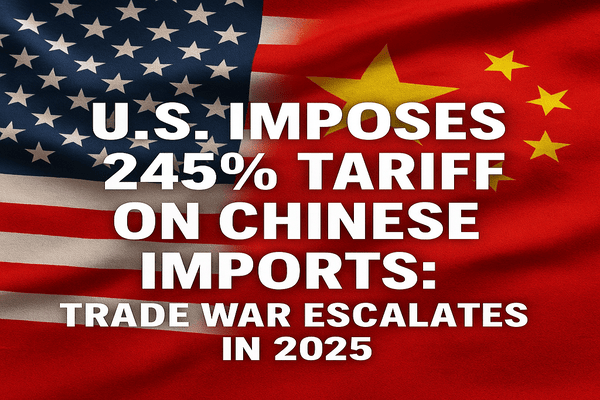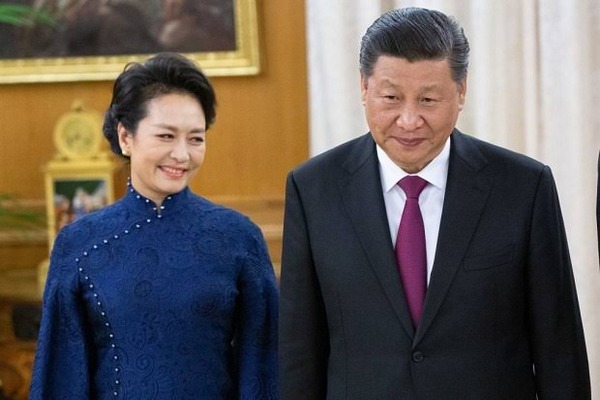April 17, 2025 – The U.S.-China trade war has intensified dramatically as the Trump administration announces new tariffs of up to 245% on select Chinese imports. This aggressive move, revealed in a White House fact sheet on April 15, targets products like electric vehicles and medical syringes, citing retaliatory actions by Beijing. But what do these skyrocketing tariffs mean for global trade, American shoppers, and the fragile relationship between the world’s two largest economies? Let’s dive into the latest trade war developments and their global implications.
What’s Behind the 245% U.S. Tariff on Chinese Imports?
The new U.S. tariff policy, effective April 15, 2025, marks a major escalation in the ongoing U.S.-China trade conflict. Certain Chinese products will now face a maximum combined tariff rate of 245%, broken down as follows:
-
A 125% retaliatory tariff implemented earlier in response to China’s trade actions.
-
A 20% tariff associated with the fentanyl crisis.
-
Pre-existing Section 301 tariffs ranging from 7.5% to 100%, intended to counter unfair trade practices.
In particular, products such as electric vehicles and syringes, already taxed at 100%, will now incur the full 245% tariff.
The White House has framed these measures as retaliation against China’s latest moves, including bans on critical mineral exports like gallium, germanium, and antimony—key elements in semiconductors, defense, and aerospace. In response, China raised its tariffs on U.S. goods to 125% on April 11, 2025, halting orders for Boeing jets and targeting U.S. agriculture and aviation sectors.
Why 245%? The Strategic Minerals Angle
According to U.S. officials, the sharply increased tariffs are a direct response to China’s stranglehold on rare earth metals, such as samarium and dysprosium, vital to national security and advanced manufacturing. On April 13, China halted exports of these minerals, prompting President Trump to issue an executive order initiating a national security investigation into U.S. dependency on imported materials.
While the 245% figure initially stirred confusion, China’s Foreign Ministry questioned the tariff’s actual scope. U.S. trade representatives later clarified that only certain goods—such as EVs and medical products—will be hit with the full rate. Others, like wool sweaters (24%) and children’s books (7.5%), will face lesser tariffs.
China’s Reaction: Confrontation or Cooperation?
China responded with a mix of defiance and openness to dialogue. Foreign Ministry spokesman Lin Jian labeled the tariffs as “blackmail” and mocked Trump’s trade strategy. However, Beijing also signaled readiness for renewed talks on the condition of “mutual respect and equal terms.”
China appears economically prepared for confrontation. Despite sanctions, its GDP grew 5.4% in Q1 2025, according to the National Bureau of Statistics. Beijing’s 125% tariffs on U.S. goods and restrictions on aerospace exports show a willingness to escalate further if provoked.
Global Impact of the U.S.-China Tariff War
The ripple effects of the 2025 tariff escalation are being felt worldwide. The World Trade Organization warns that the move could shrink global trade volumes by up to 1.5%. Singapore’s Prime Minister Lawrence Wong noted that U.S.-China trade could “grind to a halt.”
For U.S. companies that rely on Chinese manufacturing such as those in toys (75% of imports), clothing, and solar panels the cost pressures are mounting. These increases could lead to higher prices for consumers and disrupt already fragile global supply chains.
President Trump, however, insists that the tariffs are helping to reduce inflation. On Truth Social, he claimed that the new measures are “lowering prices on gasoline, groceries, and just about everything else.” But many economists dispute this, warning that supply chain strain could ultimately drive prices higher and hurt American businesses.
Winners, Losers, and the Shifting Global Landscape
While some markets suffer, others may benefit from the fallout. India, for example, is emerging as a possible winner. With companies shifting away from Chinese suppliers, India is positioning itself as a reliable trade partner. Its move to eliminate taxes on U.S. ethane and LPG imports is part of this strategic pivot.
Meanwhile, the U.S. is doubling down on domestic mineral production and considering new tariffs on semiconductors and digital services. China, in contrast, is working to strengthen alliances with the EU and Southeast Asia. President Xi Jinping recently reaffirmed China’s commitment to a “rules-based international trade system” during a regional summit tour.
What’s Next? A Trade War with No End in Sight
The message from Washington is clear: “The ball is in China’s court.” But with national security, sanctions, and the Taiwan issue complicating negotiations, a swift resolution looks unlikely.
For American households, this could mean price hikes on everyday goods from electronics and clothing to toys and home goods. For businesses, it’s a time to consider diversifying supply chains toward countries like India, Vietnam, or Mexico to mitigate long-term risks.
How Should You Prepare?
Whether you’re a consumer, business owner, or investor, here’s what you can do:
-
Consumers: Expect higher prices on certain Chinese-made goods.
-
Business owners: Explore supplier alternatives in Southeast Asia and South Asia.
-
Investors: Brace for market volatility diversification is more critical than ever.
What’s your take on these tariffs? Are they a bold move to protect American industries or a costly gamble? Let us know your thoughts in the comments, and stay tuned to our blog for ongoing updates on the U.S.-China trade war in 2025.
Sources: White House, Reuters, Times of India, CNBC TV18, Yahoo Finance, and official posts on X. For official statements, visit whitehouse.gov.










Leave a Reply